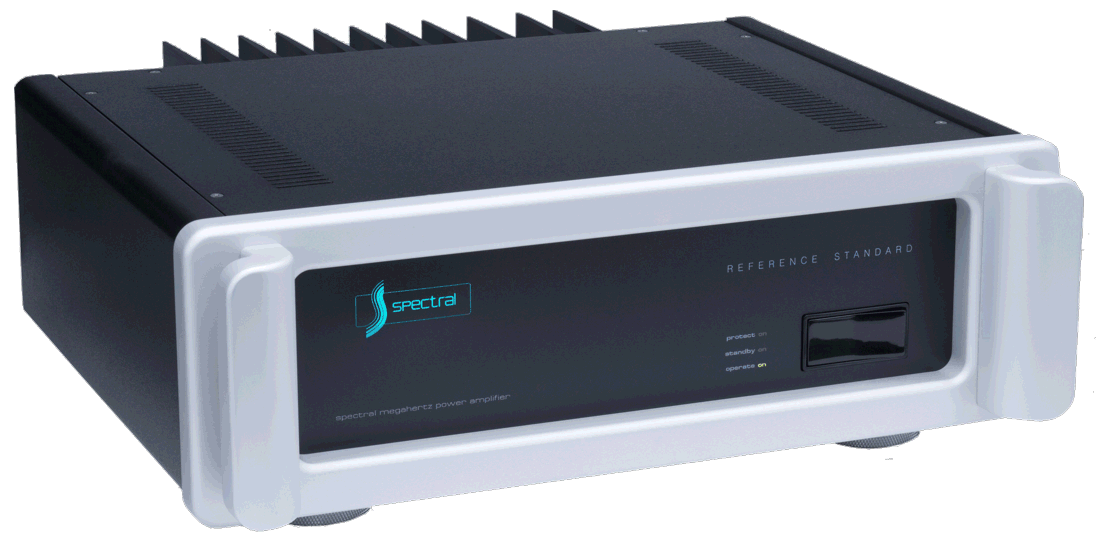


Audio components from Spectral have evolved for decades with a continuous research program that includes auditioning live music at recording sessions and careful listening trials though a variety of reference sound systems. The knowledge from this work has become an essential part of creating and evaluating promising technical concepts, new circuits and testing methods. The very best candidates, those with greatest potential to preserve a live music experience become parts of Spectral technology used to create new state-of-the-art audio products. This background work has substantiated the benefits of new semiconductors manufactured with recently developed manufacturing processes and their inclusion to make hybrid surface mount and through-hole amplifying circuits with exceptional performance. Our laboratory tests that correlate to human hearing and use music-like waveforms verify their technical advantage. The most promising circuits, those accurately conveying robust dynamics and transparency along with superlative detail and staging have become part of Spectral design and the creation of an exceptionally fine monaural amplifier, the new Spectral DMA-400 Reference Standard.
The Quest for Superior Amplification Devices
In developing new and advanced amplifier topologies, we are constantly researching available semiconductor transistors for premium devices which will be superior in Spectral high-speed analog applications, including a new generation of SMT transistors. Many of these surface mount semiconductors we could use for new designs have quicker responses and possess excellent amplification potential, yet their inclusion into carefully designed Spectral circuits would not live up to our expectations. Many were found to damage resolution and clarity. We believed that perhaps thermal stress and charge settling might be responsible since electronic evolution has favored smaller semiconductors whose junctions might respond to transient heating and produce thermally active errors. To explore this possibility we developed new sophisticated sampling tests at Spectral using simulated music waveforms to screen promising new semiconductor devices. A typical evaluation would create isolated transient events at semiconductor junctions so that heating would be similar to that from amplifying music and correction responses expected from loudspeaker loads. Such events require responses that demand brief energy bursts, which produce quick temperature surges. Then junction voltages, which should be constant might change to memorialize the event and to initiate error responses or thermal tails. Since most integrated circuit op-amp amplifiers have similar difficulties, the test methodology was made practical from working with these consumer devices. Performance limits became quantified to hearing acuity as well as human perceptual ability. These new test methodologies have now consistently verified the Spectral philosophy of inherently fast - low stress amplification to achieve ultimate resolution and accuracy. When instantaneous waveform accuracy is achieved at parts-per-million, the listening experience can become most detailed, transparent and involving. Our search for superior amplification devices led us to recent discrete semiconductors intended for premium television and computer displays. Their hefty construction and advanced manufacturing processes create a substantial and very fast device that is free of thermal tail and memorialization of error issues. These new devices can operate over a wide range of voltages and currents while being capable of excellent gain linearity, quickness and ability to amplify very high frequencies. The DMA-400 achieves its unmatched clarity and resolution from a combination of these breakthrough performances.
Developing the SHHA Driver Technology
In the course of development work for the DMA-400 RS, many different semiconductor technologies and manufacturing processes have been researched. Most promising were those featuring breakthrough manufacturing processes and computed chip geometries that produced excellent tests from both traditional tone tests and our recently developed music related test methodology. Best examples from this work often spawned unique or new circuits whose design integration required computed “re-designs” that would change many resistors and capacitors in the test amplifier. Each experiment might include new JFET, CMOS or Bipolar devices, but unlike traditional parts swapping, the test platform would be a well thought out optimum design prototype that could be realistically compared to a highly evolved Spectral reference component. The result of this research effort is the Spectral High-speed Hybrid Amplifier driver module and ideally optimized topology using the finest available transistors from both SMT and traditional leaded components technologies.
In the new SHHA driver module, surface mount technologies are essential to fully utilize the new faster devices that have been successfully tested. The SHHA driver module provides greater parts density where needed and its layouts have become more purposeful than our previous drivers. Exemplary staging and quiet amplification are hallmarks of this technology as left and right channels are extremely well isolated and free of interferences. Inherent miniaturization makes room for more and better support circuits used to regulate the amplifier, its voltages and currents, as well as to cancel magnetic fields and block electrostatic interactions that might propagate from signal, power and speaker cables. All Spectral amplifiers employ similar environmental isolation strategies, but additional fine-tuning from the SHHA surface mount hybrid technology greatly improves this ability. It also provides tight thermal coupling to evenly distribute temperatures allowing higher biasing currents that improve dynamic headroom. The important gain path from microvolt sensitive JFET devices to the powerful compact MOSFET output section is now direct and clean for effortless amplification. All combined, the new hybrid surface mount construction and advanced active devices of the SHHA driver improve accuracy, speed, power capability and provide greater stability margins that are necessary for supporting the DMA-400 ‘Focused Array’ high-speed, high-current output.
Innovative New Semiconductors in Gain Stage
Complimenting the high performance SHHA driver in the DMA-400 RS is a new and advanced gain stage which features custom semiconductor technology developed for high-resolution display applications. These new high-speed, high voltage devices are a rarity in an industry increasingly focused on low voltage transistors for mobile products. Our experiments with various custom packaging options has resulted in powerful, high-speed devices which exhibit virtually no thermal tail energy storage. To fully exploit these remarkable devices, a new double push-pull, fully balanced gain topology is employed. In this configuration, the custom gain devices deliver nearly twice the speed of previous Spectral gain sections with lower impedance and improved drive matching to the amplifier outputs. With ideal output section drive and slew symmetry from the new gain topology, intrinsic amplifier slew increases to over 650 V/uS, our best performance to date. The DMA-400 RS gain section echoes advances made in the SHHA driver with faster settling, new devices for ultra-fast transient resolution with deep dynamic settling capability.
The DMA-400 RS Optimized System
Circuits, devices, layouts and construction aspects of Spectral amplifiers are carefully engineered and structured to work together as a system capable of producing a highly refined level of performance. All assemblies and most components inside the DMA-400 are revised and improved to fully realize the virtues of the new SHHA driver board and fully balanced gain section. These improvements are necessary to fulfill the Spectral uncompromised design philosophy.
Along with the innovative new SHHA driver section the DMA-400 features new power supply design and transformers. These larger transformers have the tightest regulation and isolation we have yet achieved, with the ability to energize tough, low impedance loads. Remarkably, this greater level of performance can be met in an amplifier of relatively compact size and moderate weight.
The new generation amplifier systemboard of the DMA-400 features advanced RF layout techniques for ultra stable high frequency operation without ferrite stabilization or capacitors in the signal path. New “high plate” pc board technology offers three times the trace thickness previously possible for vastly improved current capability and trace density.
All new signal cables and precision grounding system are designed to exploit the very high isolation capacity of the new SHHA driver and balanced gain section. Audio paths are direct and short as possible with minimal filtering for the lowest possible noise and extreme quiet signal resolution and transient settling.
The Result: Instantaneous Amplifier Accuracy
In the DMA-400 RS, Spectral further develops the SHHA driver technology, a radically improved amplifier topology featuring double the speed and signal response of our previous drivers. At these elevated speeds, device energy storage and thermal memory can now be observed as significant signal distortions, bluring transient detail and smearing instrument decay and interplay. Sophisticated new testing methodology identifies these fast-moving, thermal tail artifacts and directs their elimination in the advanced new SHHA driver topology. Combined with the innovative push-pull, balanced gain section, the new SHHA driver achieves parts-per-million waveform accuracy and the lowest distortion levels attained in an audio amplifier. The long sought after ideal of ‘instantaneous accuracy’ with virtually no signal memory is significantly realized in the DMA-400 Monaural Reference Standard, the most advanced audio amplifier yet from Spectral Audio.